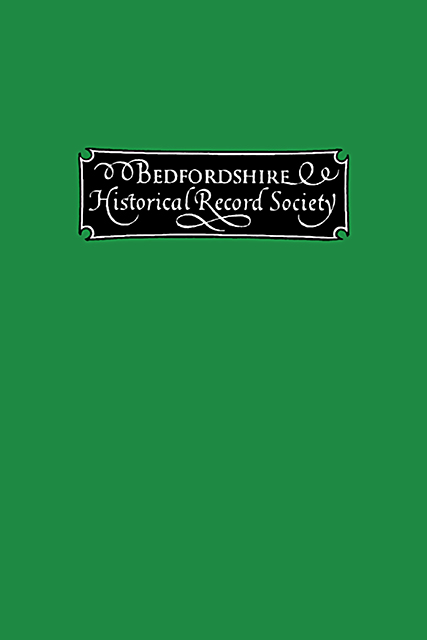Book contents
- Frontmatter
- Contents
- Rules for Transcription
- Abbreviations in Common Use
- The Assessment of Knight Service in Bedfordshire: No. II.
- St. John of Southill
- Some Saxon Charters
- A Late Example of A Deodand
- Domesday Notes : II. Kenemondwick.
- The Hillersdens of Elstow
- Grant of Free Warren to Newnham Priory
- Cutenho, Farley Hospital, and Kurigge.
- Munitions In 1224
- The Becher Family of Howbury
- Yttingaford and the Tenth-Century Bounds of Chalgrave and Linslade
- The Paper Register of St. Mary’S Church in Bedford, 1539-1558
- Calendar of Inquisitions Post Mortem. No. I.
- Notes and Queries
- Index
- Miscellaneous Endmatter
The Assessment of Knight Service in Bedfordshire: No. II.
Published online by Cambridge University Press: 14 July 2023
- Frontmatter
- Contents
- Rules for Transcription
- Abbreviations in Common Use
- The Assessment of Knight Service in Bedfordshire: No. II.
- St. John of Southill
- Some Saxon Charters
- A Late Example of A Deodand
- Domesday Notes : II. Kenemondwick.
- The Hillersdens of Elstow
- Grant of Free Warren to Newnham Priory
- Cutenho, Farley Hospital, and Kurigge.
- Munitions In 1224
- The Becher Family of Howbury
- Yttingaford and the Tenth-Century Bounds of Chalgrave and Linslade
- The Paper Register of St. Mary’S Church in Bedford, 1539-1558
- Calendar of Inquisitions Post Mortem. No. I.
- Notes and Queries
- Index
- Miscellaneous Endmatter
Summary
VI.—THE BARONY OF BEAUCHAMP OF BEDFORD.
We may start with what was said in Vol. I. by Dr. Fowler and Mr. Chambers. Hugh de Beauchamp had been sheriff of Bedfordshire at some date before the survey for Domesday Book was made; he succeeded Ralf Talboys in that office, and presumably in most of his lands; there is reason to believe that he married a daughter of Ralf and Azeline, and the lands which were registered in Domesday Book in the holding of Azeline as Ralf’s widow were afterwards part of the Beauchamp barony. In later days Bedford was reckoned as the caput baroniæ; the barony was said to be “ of Bedford “; likewise one Beauchamp after another held Bedford castle as if the castellanship was hereditary by right. Yet borough and castle were alike royal, and King John was quite free to appoint the famous Falkes de Breauté in place of the Beauchamp who upheld the cause of Magna Carta. One’s general impression is that the first Hugh was a pushing man, sheriff and chief landowner in the county, ready to grasp other properties when he had the chance, and to look upon Bedford and its castle as his own; apparently also some of his descendants were of a similar type.
Some introduction of this kind is necessary to any account of the Beauchamp fief, because in addition to Hugh’s own lands, as given in D.B., whether his own originally or taken over by him as Ralf’s successor and heir, we find that his successors held the whole of the lands of Azeline, of Albert the Lorrainer, and of Turstin, also some of the lands of Countess Judith, and a few stray virgates of a certain Chelbert and Osbern. Hugh’s own hides I add up to 173½ in Beds., scattered all over the county, 19 in Bucks., and 10 in Herts. It is somewhat rare to find a baron holding so considerable a proportion all in one county, but we know from D.B. that there was an exchange made, between 1066 and 1086, of Beds, lands against those of Ware in Herts.
- Type
- Chapter
- Information
- Publisher: Boydell & BrewerFirst published in: 2023

